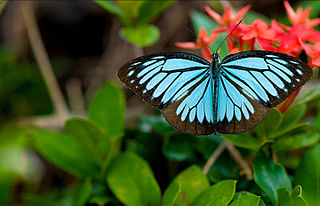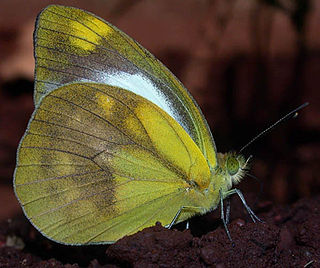Related Research Articles

Pareronia valeria, the common wanderer or Malayan wanderer, is a medium-sized butterfly of the family Pieridae, that is, the yellows and whites, and is found in India and Southeast Asia. The butterfly found in India is sometimes considered as a separate species, Pareronia hippia.

Cepora nadina, the lesser gull, is a small to medium-sized butterfly of the family Pieridae, that is, the yellows and whites. The species was first described by Hippolyte Lucas in 1852. It is native to Sri Lanka, India, Myanmar, Hainan, and southeast Asia.

Miletus symethus, the great brownie, is a small butterfly found in India that belongs to the lycaenids or blues family. The species was first described by Pieter Cramer in 1777.

Cethosia nietneri, the Tamil lacewing, is a species of nymphalid butterfly found in Sri Lanka and south India. The species name is after John Nietner who obtained specimens of the butterfly from Ceylon from which it was described.

Euchaetis rhizobola is a moth of the family Oecophoridae. It is found in Australia, including New South Wales, Queensland, the Australian Capital Territory, Victoria, South Australia and Western Australia.
Cosmopterix galapagosensis is a moth of the family Cosmopterigidae. It is known from the Galapagos Islands.
Pebobs kale is a moth of the family Cosmopterigidae. It is known from Peru and Trinidad and Tobago.
Pebobs sanctivincenti is a moth of the family Cosmopterigidae. It is known from Grenada and Saint Vincent and the Grenadines.
Nites grotella, the hazel leaftier moth, is a moth in the family Depressariidae. It was described by Robinson in 1870. It is found in North America, where it has been recorded from Nova Scotia to New York, as well as in Manitoba and Ontario.
Ardozyga thyrsoptera is a species of moth in the family Gelechiidae. It was described by Edward Meyrick in 1904. It is found in Australia, where it has been recorded from Queensland.
Calliprora rhodogramma is a moth of the family Gelechiidae. It is found in Brazil (Amazonas).
Charistica ioploca is a moth in the family Gelechiidae. It was described by Edward Meyrick in 1922. It is found in Amazonas, Brazil.
Idiophantis habrias is a moth of the family Gelechiidae. It was described by Edward Meyrick in 1904. It is found in Australia, where it has been recorded from Queensland.
Antaeotricha rostriformis is a moth of the family Depressariidae. It is found in French Guiana.
Stenoma bryocosma is a moth of the family Depressariidae. It is found in French Guiana and Brazil.
Scorpiopsis pyrobola is a moth in the family Depressariidae. It was described by Edward Meyrick in 1887. It is found in Australia, where it has been recorded from Queensland and New South Wales.
Odites carcharopa is a moth in the family Depressariidae. It was described by Edward Meyrick in 1914. It is found on the Comoros in the Indian Ocean.
Hypercallia cyathopa is a moth in the family Depressariidae. It was described by Edward Meyrick in 1913. It is found in Colombia.
Imma tetrope is a moth in the family Immidae. It was described by Alexey Diakonoff in 1978. It is found in Nepal.
Moca roscida is a moth in the family Immidae. It was described by Edward Meyrick in 1922. It is found in Brazil.
References
- ↑ Nuss, M.; et al. (2003–2014). "GlobIZ search". Global Information System on Pyraloidea. Retrieved 2014-07-15.
- ↑ CSIRO Ecosystem Sciences - Australian Moths Online
- ↑ XIII. Descriptions of some exotic Micro-Lepidoptera
| This Margaroniini-related article is a stub. You can help Wikipedia by expanding it. |